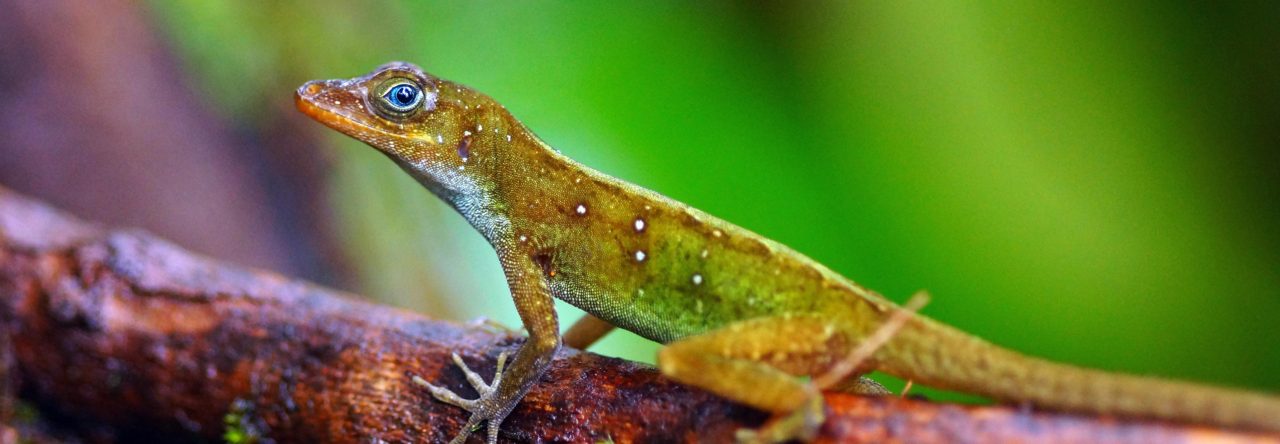On march 19, 2013, Jonathan Losos wrote about Anolis heterodermus in this blog, on a post called “Adventures with Phenacosaurus”: “…I have to comment on the little-studied thermal biology of this species. The weather when we were there was usually overcast with the sun occasionally bursting out. Temperatures were usually in the 16-20̊ range. And the lizards were active! Moreover, we were at only about 2600 meters, but I have heard reports of them being found as high as 4000 meters! Clearly, a study on the thermal biology of this species would be fascinating!” One year later, I began to investigate this topic on A. heterodermus.
All my life I’ve loved reptiles, but only recently as part of my undergraduate studies in biology in the National University of Colombia, have I started in the herpetological world with Drs. Adriana Jerez and Martha Calderón. I was particularly intrigued by the thermal biology of these organisms. Soon I discovered that I’ve always lived in a high-elevation, cold city, Bogotá, in a neotropical country, Colombia, making the reptile species around me, which are ironically unknown, perfect models for questions about thermoregulation in reptiles.

A female Anolis heterodermus
As I tried to decide which of these species would be my model for my undergraduate thesis, I realized that my professors and some of my colleagues had already started to study some of the high-elevation species, like the high-Andean snake Atractus crassicaudatus, the microteiid Anadia bogotensis, and the collared tropidurids Stenocercus trachycephalus and S. lache. I realize now that my choice of the high-Andean lizard Anolis heterodermus for my study was one of the best decisions of my life as a biologist.
Between 2014 and 2015, I carried out my undergraduate thesis research under the direction of Dr. Martha Calderón on thermoregulation of Anolis heterodermus in Tabio, a town at 2650 m asl, close to Bogotá, Colombia. During my research, Martha, my colleagues and I had the opportunity to know Dr. Barry Sinervo and his group, who helped us with equipment and suggestions for our projects. Finally, in 2017, after my thesis was approved and I obtained my biology university degree, Martha and I published my first article.

Measuring an individual of Anolis heterodermus with calipers
Anolis heterodermus lives in a cold, low-quality thermal habitat that gets worse in wet seasons. Surprisingly, during the wet season, Anolis heterodermus copes succesfully with this seasonal variation and adjusts behaviorally to thermoregulate more actively to compensate for the reduction in the thermal quality of the habitat. In this way, these lizards match achieve their preferred temperatures just as in dry season. This match also occurs mostly at midday, particularly in sunny perch sites, confirmed by operative temperature data, which suggests that A. heterodermus is a heliothermic species. Additionally, sexes and ages are not different in their thermal traits, such as body and preference temperatures.

Study site: Tygüa Magüe Ecopark, Tabio, Colombia, at 2650 m asl.
But the most incredible trait of this species is its capacity to take advantage of the few sunny hours and sunny microhabitats to thermoregulate, taking into account that the tropical high-elevation ecosystems like the high-andean shrubs and forest, and subparamo and paramo not always are cold environments, but have large thermal fluctuation during the day too, which is reflected in the wide range of body (16.6-31.9°C) and preferred (19.1-30.2°C) temperatures. Definitely Anolis heterodermus is a very plastic thermoregulating species, as it has to be, because it is the anole species found at the highest altitude known.
Cite: Méndez-Galeano, M. A., & Calderón-Espinosa, M. L. (2017). Thermoregulation in the Andean lizard Anolis heterodermus (Squamata: Dactyloidae) at high elevation in the Eastern Cordillera of Colombia. Iheringia. Série Zoologia, 107.
Photos: Andres Herrera

 Recently, a friend found the anole pictured above in Mompiche, Ecuador. As of now, the identity of this anole remains unknown.
Recently, a friend found the anole pictured above in Mompiche, Ecuador. As of now, the identity of this anole remains unknown.








